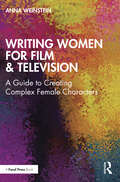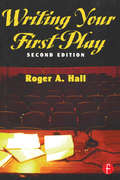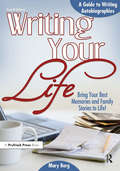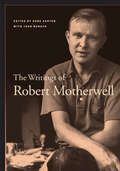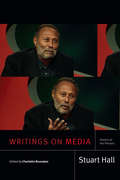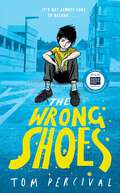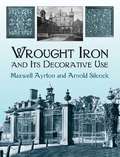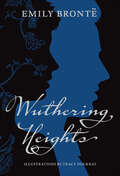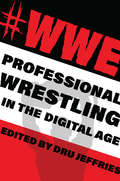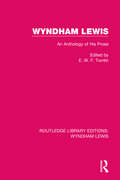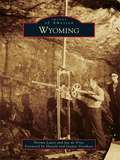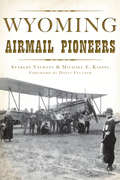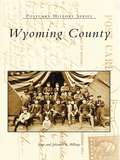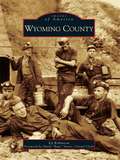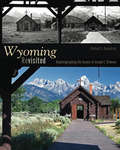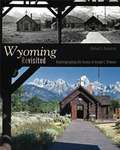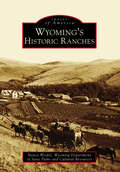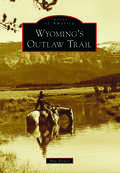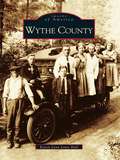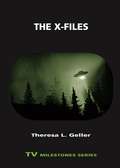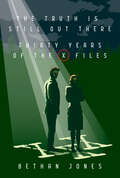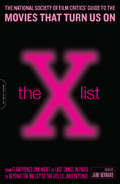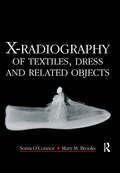- Table View
- List View
Writing Women for Film & Television: A Guide to Creating Complex Female Characters
by Anna WeinsteinThis book is a detailed guide to creating complex female characters for film and television. Written for screen storytellers of any level, this book will help screenwriters and filmmakers recognize complicated portrayals of women on screen and evaluate the complexity of their own characters. Author Anna Weinstein provides a thorough analysis of key female characters in film and television, illustrating how some of our greatest screenwriters have developed smart, nuanced, and intriguing characters that successfully portray the female experience. The book features in-depth discussions of women’s representation both on screen and behind the scenes, including interviews with acclaimed women screenwriters and directors from around the globe. These conversations detail their perspectives on the relevance of women’s screen stories, the writing and development processes of these stories, and the challenges in getting female characters to the screen. With practical suggestions, exercises, guidelines, and a review of tired clichés to avoid, this book leaves readers prepared to draw their own female characters with confidence. A vital resource for screenwriters, filmmakers, and directors, whether aspiring or already established, who seek to champion the development of rich, layered, and unforgettable female characters for film and television.
Writing Your First Play
by Roger HallWriting Your First Play provides the beginning playwright with the tools and motivation to tell a story through dramatic form. Based in a series of exercises which gradually grow more complex, the books helps the reader to understand the basic elements of drama, conflict, and action. The exercises help the reader to become increasingly sophisticated in the use of dramatic formats, turning simple ideas into a viable play. Topics include: the role of action in drama;developing action and conflict to reveal character;writing powerful and persuasive dialog;writing from personal experience:pros and cons;how to begin the story and develop the storyline. This new edition is thoroughly updated and contains new examples based on contemporary plays. The author has added additional writing exercises and a new student-written one act play. It also contains a new chapter on how to sell your play once it is written.With examples based on student work, this text both inspires and educates the student and fledgling playwright, providing solid tools and techniques for the craft of writing a drama. Roger A. Hall, a professor of theatre at James Madison University, had taught playwriting for nearly 20 years. Many of his students have gone on to write for theatre, television, and the screen. He has written numerous plays and articles and has acted and directed extensively in the theatre.
Writing Your Life: A Guide to Writing Autobiographies
by Mary BorgTo many, the task of writing about one's life seems daunting and difficult. Where does one begin? What stories will inspire your children and grandchildren, and which will simply amuse them? Writing Your Life: A Guide to Writing Autobiographies breaks down the barriers of personal narrative with an easy-to-follow guide that includes thought-provoking questions, encouraging suggestions, memory-jogging activities, tips for writing, advice on publishing one's stories in print and online, and examples of ordinary people's writing. Writing Your Life has already helped thousands write their life stories, and this fourth edition is sure to help today's writers preserve their memories and wisdom for many generations to come.
The Writings of Robert Motherwell (Documents of Twentieth-Century Art)
by Robert MotherwellRobert Motherwell (1915-1991), one of the leading American Abstract Expressionist painters, was also a theorist and exponent of the movement. His writing articulated the intent of the New York school —Jackson Pollock, Willem de Kooning, Adolph Gottlieb, Franz Kline, Arshile Gorky, and others—during a period when their work was often reviled for its departure from traditional representation. As founder of the Documents of Modern Art series (later renamed the Documents of Twentieth-Century Art), Motherwell gave modern artists a voice at a time when very few people understood their theories or work. This authoritative new edition of the artist's writings about art includes public lectures, essays, and interviews. Impeccably edited, with an informative introductory essay and rigorous annotation, it is illustrated with black-and-white images that elucidate Motherwell's writings.
Writings on Media: History of the Present (Stuart Hall: Selected Writings)
by Stuart HallWritings on Media gathers more than twenty of Stuart Hall's media analyses, from scholarly essays such as “Encoding and Decoding in the Television Discourse” (1973) to other writings addressed to wider publics. Hall explores the practices of news photography, the development of media and cultural studies, the changing role of television, and how the nation imagines itself through popular media. He attends to Britain's imperial history and the politics of race and cultural identity as well as the media's relationship to the political project of the state. Testifying to the range and agility of Hall's critical and pedagogic engagement with contemporary media culture—and also to his collaborative mode of working—this volume reaffirms his stature as an innovative media theorist while demonstrating the continuing relevance of his methods of analysis.
The Wrong Shoes: The vital new novel from the bestselling creator of Big Bright Feelings
by Tom PercivalA beautiful and urgent exploration of the experience of child poverty from Tom Percival, creator of the bestselling Big Bright Feelings series, for fans of Boy at the Back of the Class. Working in partnership with the National Literacy Trust, £1 from the sale of a hardback copy in the UK will go towards supporting children in poverty. 'Powerful and moving with the potential to change lives' Hannah Gold'Full of empathy and most importantly, heart' Phil EarleThere's a bunch of kids in there and suddenly they're all looking at me like someone who can actually do something, not just some weirdo with the wrong shoes and a rubbish coat . . . Will has the wrong shoes – he's always known it but doesn't know how to change it. Navigating the difficulties of home and school when you feel you stick out is tough, but finding confidence with the help and empathy of friends can be all you need to see the way. Praise for The Wrong Shoes: &‘An extraordinary, powerful and moving book that has the potential to change lives.&’ Hannah Gold &‘Every chapter is full of experience & empathy & most importantly, heart&’ Phil Earle &‘Reading fiction is about walking in the shoes of people whose lives are very different to ours and allowing more readers to see themselves in stories. The Wrong Shoes is the perfect example of both – the right book at the right time&’ Tom Palmer &‘A brilliant book – such a perfect marriage of words and illustrations and an important story told with real heart&’ Christopher Edge &‘A hopeful, honest, big-hearted read. You&’ll be rooting for the main character, Will, from the very first page . . . &’ Clara Vulliamy &‘A beautifully illustrated, deeply moving, empathy-boosting story . . .&’ Rashmi Sirdeshpande &‘A superbly courageous and timely book. Will is a protagonist so many children and adults will identify with, really beautiful&’ Steven Lenton
Wrought Iron and Its Decorative Use
by Arnold Silcock Maxwell AyrtonA superb treasury of decorative wrought iron, this well-illustrated volume presents an informative survey of the ancient craft's practice throughout England. Its history can be traced simply by admiring the crisp black-and-white illustrations of gates, railings, screens, and other elaborately rendered works. 241 black-and-white illustrations.
WTF, Evolution?!: A Theory of Unintelligible Design
by Mara GrunbaumWe all have our off days. Why should Evolution be any different? Maybe Evolution got carried away with an idea that was just a little too crazy—like having the Regal Horned Lizard defend itself by shooting three-foot streams of blood from its eyes. Or maybe Evolution ran out of steam (Memo to Evolution: The Irrawaddy Dolphin looks like a prototype that should have been left on the drawing board). Or maybe Evolution was feeling cheeky—a fish with hands? Joke’s on you, Red Handfish! Or maybe Evolution simply goofed up: How else to explain the overgrown teeth of the babirusas that curl backward over their face? Oops. Mara Grunbaum is a very smart, very funny science writer who celebrates the best—or, really, the worst—of Evolution’s blunders. Here are more than 100 outlandish mammals, reptiles, insects, fish, birds, and other creatures whose very existence leaves us shaking our heads and muttering WTF?! Ms. Grunbaum’s especially brilliant stroke is to personify Evolution as a well-meaning but somewhat oblivious experimenter whose conversations with a skeptical narrator are hilarious. For almost 4 billion years, Evolution has produced a nonstop parade of inflatable noses, bizarre genitalia, and seriously awkward necks. What a comedian!
Wuthering Heights
by Emily Brontë Tracy DockrayWuthering Heights is one of the world's greatest tales of unrequited love, captivating readers with its intense passion and drama since its publication in 1847. In this special collector's edition, the powerful, complex bond between Heathcliff and Catherine that unfolds in the wild, romantic landscape of the Yorkshire moors is beautifully presented in illustrated form for the first time.
#Wwe: Professional Wrestling in the Digital Age (The Year's Work: Studies in Fan Culture and Cultural Theory)
by Dru JeffriesThe millions of fans who watch World Wrestling Entertainment (WWE) programs each year are well aware of their role in building the narrative of the sport. #WWE: Professional Wrestling in the Digital Age explores the intersections between media, technology, and fandom in WWE's contemporary programming and business practices. In the Reality Era of WWE (2011 to the present), wrestling narratives have increasingly drawn on real-life personalities and events that stretch beyond the story-world created and maintained by WWE. At the same time, the internet and fandom have a greater influence on the company than ever before. By examining various sites of struggle and negotiation between WWE executives and in-ring performers, between the product and its fans, and between the company and the rest of the wrestling industry, the contributors to this volume highlight the role of various media platforms in shaping and disseminating WWE narratives. Treating the company and its product not merely as sports entertainment, but also as a brand, an employer, a company, a content producer, and an object of fandom, #WWE conceptualizes the evolution of professional wrestling's most successful company in the digital era.
Wyndham Lewis: An Anthology of His Prose (Routledge Library Editions: Wyndham Lewis #3)
by E. W. F. TomlinOriginally published in 1969, this project had Wyndham Lewis’ personal approval and is a comprehensive anthology of his prose writings, especially those which are difficult to access. There are extracts from some of Wyndham Lewis’ remarkable books such as Paleface, The Art of Being Ruled and Men Without Art. Lesser known works such as Filibusters in Barbary, The Diabolical Principle and The Dithyrambic Spectator, Blasting and Bombardiering, and Rude Assignment, are freely drawn upon and there is a section devoted to writings on the USA, a country which Lewis knew well.
Wyoming
by Jay De Vries Norma LewisWyoming, Michigan, became a city in 1959, the same year Alaska and Hawaii became states, but its history began more than a century earlier. The first permanent settlers came in 1832, and in 1848, the region split, with the northern portion becoming Wyoming and the southern, Byron Center. Wyoming flourished. The farmers came first with the businesses that supported them. Industry followed. The various gypsum mines were among the earliest arrivals. General Motors built a stamping plant on Thirty-sixth Street that helped pull the township out of the Great Depression in 1936. It was a success, so the company built a diesel plant on Burlingame Avenue. Reynolds Metals, Steelcase, Light Metals, Bell Fibre, and others found Wyoming a good place to relocate. People wanted to live where they worked, and that meant an ever-increasing number of houses were built, followed by additional schools, churches, shops, and restaurants. Rogers Plaza was West Michigan's first enclosed mall. Though often contentious, the local government did its best to live up to an ambitious slogan, "Wyoming: the City of Vision and Progress."
Wyoming Airmail Pioneers (Transportation)
by Foreword By Feltner Starley Talbott KasselThe story of the United States Transcontinental Air Mail Service, the first of its kind in the world, is one of romanticism and danger. Through calm or storm, in light or dark, a contingent of courageous couriers relayed the public mail across three thousand miles in less than a day and a half—faster than ever before. Though the U.S. Air Mail Service began on the East Coast, some of the frontier tales of the route through the Rocky Mountains were lost. The western leg of the airmail service from Chicago to San Francisco included the Mountain Division, headquartered in Cheyenne, Wyoming. The route through Wyoming, considered the most treacherous, provided harrowing tales of the pilots who risked their lives. Authors Starley Talbott and Michael Kassel lionize these folk heroes, aviation legends and icons of western history.
Wyoming County
by Johanna S. Billings Sean BillingsWyoming County features postcards highlighting the history of communities nestled in the Endless Mountains. These unique images explore important industries such as the Noxen Tannery and the Lehigh Valley and Delaware, Lackawanna & Western Railroads. Numerous photographs depict the county seat, Tunkhannock, as well as the surrounding towns, such as the former resort areas of Lake Carey and Lake Winola; Vernon and Vose, which have almost completely disappeared; and Laceyville, which appears almost untouched by time. From an early hospital in Meshoppen to scenes near Falls, Mill City, and Mehoopany, Wyoming County is sure to delight both residents and visitors.
Wyoming County
by Ed Robinson David Bugs" StoverBecause of its rich coal heritage and breathtaking scenery, many regard Wyoming County as the hidden gem of southern West Virginia. The county's vibrant history began with Native Americans, whom many believe left behind the petroglyphs that attract national attention, and continued to its early residents, who farmed and flourished in the logging industry. In 1906, when the Deepwater Railroad (later the Virginian) came to the town of Mullens, Wyoming County's role as a provider of the nation's natural resources was strengthened. By the 1920s, the county was one of West Virginia's foremost coal-producing counties; it maintains that position today. In addition to its integral part in resource exportation, Wyoming County is legendary for its sports scene. Such great players and coaches as Curt Warner, star running back of Penn State and the Seattle Seahawks; Mike D'Antonio, head coach of the Phoenix Suns; and Joe Pendry, assistant coach of the Houston Texans, got their start in Wyoming County. In recent years, this area has been best known for its recreational opportunities. Twin Falls State Park and R. D. Bailey Lake attract thousands of tourists annually, and the Coal Heritage Trail gives residents and visitors alike a chance to see how coal influenced the growth of the region.
Wyoming Revisited: Rephotographing the Scenes of Joseph E. Stimson
by Michael A. AmundsonIn Wyoming Revisited, Michael A. Amundson uses the power of rephotography to show how landscapes across the state have endured over the last century. Three sets of photographs—the original black-and-white photographs taken by famed Wyoming photographer Joseph E. Stimson more than a century ago, repeat black-and-white images taken by Amundson in the 1980s, and a third view in color taken by the author in 2007–2008—are accompanied by captions explaining the history and importance of each site as well as information on the process of repeat photographic fieldwork. The 117 locations feature street views of Wyoming towns and cities, as well as views from the state's famous natural landmarks like Yellowstone National Park, Grand Teton National Park, Devil's Tower National Monument, Hot Springs State Park, and Big Horn and Shoshone National Forests. In addition, Amundson provides six in-depth essays that explore the life of Joseph E. Stimson, the rephotographic process and how it has evolved, and how repeat photography can be used to understand history, landscape, historic preservation, and globalization. Wyoming Revisited highlights the historic evolution of the American West over the past century and showcases the significant changes that have occurred over the past twenty-five years. This book will appeal to photographers, historians of the American West, and anyone interested in Wyoming's history or landscape. The publication of this book is supported in part by the Wyoming Cultural Trust Fund.
Wyoming Revisited: Rephotographing the Scenes of Joseph E. Stimson
by Michael A. AmundsonIn Wyoming Revisited, Michael A. Amundson uses the power of rephotography to show how landscapes across the state have endured over the last century. Three sets of photographs—the original black-and-white photographs taken by famed Wyoming photographer Joseph E. Stimson more than a century ago, repeat black-and-white images taken by Amundson in the 1980s, and a third view in color taken by the author in 2007–2008—are accompanied by captions explaining the history and importance of each site as well as information on the process of repeat photographic fieldwork.<P> The 117 locations feature street views of Wyoming towns and cities, as well as views from the state's famous natural landmarks like Yellowstone National Park, Grand Teton National Park, Devil's Tower National Monument, Hot Springs State Park, and Big Horn and Shoshone National Forests. In addition, Amundson provides six in-depth essays that explore the life of Joseph E. Stimson, the rephotographic process and how it has evolved, and how repeat photography can be used to understand history, landscape, historic preservation, and globalization.<P> Wyoming Revisited highlights the historic evolution of the American West over the past century and showcases the significant changes that have occurred over the past twenty-five years. This book will appeal to photographers, historians of the American West, and anyone interested in Wyoming's history or landscape.<P> The publication of this book is supported in part by the Wyoming Cultural Trust Fund.
Wyoming's Historic Ranches
by Nancy Weidel Wyoming Department of State Parks and Cultural ResourcesWyoming is so closely identified with ranching that it is often known as "the Cowboy State." The prosperity associated with the cattle industry drew wealthy investors to Wyoming Territory in the 1870s and early 1880s. They stocked the range with thousands of cows and made considerable fortunes until the harsh winter of 1886-1887, when the cattle market collapsed. Many of those early ranchers left Wyoming, which opened the door for the establishment of what would become a huge sheep business. During the 1890s and the early decades of the 20th century, the various Homestead Acts drew others to Wyoming in search of a brighter future. As most of Wyoming's land was suited for grazing, not farming, smaller ranches began to play a more important role in the state's growth. Wyoming's Historic Ranches provides a rare glimpse of the cattle baron ranches as well as the more modest operations that are tucked away along remote valleys and streams, not visible to the average visitor or resident of the state.
Wyoming's Outlaw Trail
by Mac BlewerA historic and folkloric path that meandered from Canada to Mexico, the Outlaw Trail was used by outlaws such as Butch Cassidy, the Sundance Kid, and the James brothers. Following existing Western routes such as the Oregon Trail, the highway connected towns and natural hideouts essential for bandits escaping the law. Some in Western communities were sympathetic toward the outlaws. Many, like Cassidy, were seen as Robin Hoods, fighting for common people who were under siege by economic forces, corporate encroachment, and other changes occurring in the Old West. Images of America: Wyoming's Outlaw Trail details the history, folklore, and geography behind some of Wyoming's outlaw towns and hideouts--chief among them the Hole in the Wall and Red Desert. Also highlighted are the deeds of the robbers, lawmen, and ordinary folk who rode those dusty trails during the late 1800s and early 1900s.
Wythe County
by Karen Lynn HallNestled in the heart of the Blue Ridge Mountains of Southwest Virginia lies the historically rich Wythe County. The area was originally settled due to the proximity of the New River, one of few rivers in the world that flows north. The county is named after George Wythe, signer of the Declaration of Independence. In 1863, the Civil War Battle of Wytheville brought federal troops into the heart of the county, hoping to interrupt the flow of necessary salt from the mines at nearby Saltville. During the 1800s, Wythe County was known for its mineral waters and as a mountain resort for wealthy residents of hot, humid areas who came for the summer to vacation. Having flourished throughout the 20th century, the county still retains its rural charm. Wythe County captures many charming scenes of country life, Virginia's train and travel industry, numerous long-forgotten vistas, some of Wythe County's finest citizens, and the area's most notable landmarks.
WYXIE Wonderland: An Unauthorized 50-Year Diary of WXYZ Detroit
by Dick OsgoodWYXIE WONDERLAND, by Dick Osgood, is a good time and more than that. Here is possibly the first comprehensive exploration into the inner workings of a broadcasting enterprise. It is as broad as it is deep, revealing the secrets of top management as completely as--perhaps even more fully than--it does the vagaries of performing talent. It is not a purely local story. Fifty years of national radio and television history--1925-1975--are reflected in the fundamental and accidental specifics of a single station--WXYZ, Detroit-AM, FM and TV. This is the diary of that station, unauthorized and independently written. WYXIE WONDERLAND was much more than the birthplace of The Lone Ranger, The Green Hornet and Sergeant Preston of the Yukon. It was the starting point of SOUPY SALES and MIKE WALLACE, of DOUGLAS EDWARDS and JOHN HODIAK, of GEORGE SEATON, MARTHA SCOTT and DANNY THOMAS. Here are the hilarious fluffs, minor on-the-air disasters and a phantom broadcast. This extraordinary book traces the beginnings of five networks; it follows the rise and decline of radio network programming. It sees the radio actor replaced by--the disc jockey. There are record hops with FABIAN, CHUCK BERRY and STEVIE WONDER. WYXIE WONDERLAND explains how the scandal of radio payola grew out of the discovery of rigged TV quiz programs. It tells of a sound created in Texas that revolutionized radio, and how the Top 40 format emerged from a bar in Omaha. The confusion of early television is in it as well as of early radio, and the nefarious underground beginnings of FM. Alcoholism is discovered to be something of an occupational disease. The infighting among stations and executives for ratings, accounts and position gets tough. Personalities clash. There are victories and surprising defeats.
The X-Files (TV Milestones Series)
by Theresa L. GellerPremiering in 1993 on FOX Network, The X-Files followed the investigations of two FBI special agents, Fox Mulder and Dr. Dana Scully as they pursued the supernatural, the bizarre, and the alien, as well as the government conspiracies at work to conceal the truth of their existence. For nine seasons, Chris Carter’s series broke new ground in complex narrative television by integrating science fiction and horror with the forensic investigation of the detective genre. Shaped by the conspiracy films of the 1970s, the series had the ability to comment on the contemporary political climate one week and poke fun at its own self-seriousness the next. Responding to its cinematic visual style, haunting score, complex and nuanced writing, witty dialog, and the exceptional acting of David Duchovny and Gillian Anderson, who elevated the show with their chemistry, fans embraced The X-Files, making it one of the most beloved cult television series to this day. The aim of this book is to provide the reader with several points of entry into the television series, with social, cultural, and political analyses framed by the examination of the show’s many overlapping genres. Divided into chapters highlighting the episodic standalones known as the “monster-of-the-week” (MOTW) and the serial mythology or “mytharc,” the first section of the book explores the ways the MOTWs represented social differences in stories of fantastic, supernatural beings both strange and estranged. Through comparative analyses and detailed discussions of individual episodes, it becomes clear that the MOTWs were less concerned with the alien than with alienation, using the figure of the “monster” to focus on a range of ethnic, racial, and social outsiders. The latter half of the book turns to the serialized mythology, examining both the arc of the alien conspiracy as well as the fan-driven relationship between Mulder and Scully. While the romance subplot was powered in part by the show’s fans, the alien-government conspiracy mythology was Carter’s unique vision. This volume argues that The X-Files was a milestone because it employed the generic tropes of science fiction to call our attention to contemporary global politics and the history behind them. Specifically, Theresa Geller maps the ways the series used the mytharc not to predict the future, but to unbury the violence and injustice of our own past. With its return to television as an “event series” in 2016, this volume offers a timely assessment of the show’s cultural relevance and social significance. Fans of the show, as well as readers interested in cultural studies, genre criticism, race and ethnicity, fan studies, social commentary, and gender studies will appreciate this insightful examination of the series.
The X-Files The Truth is Still Out There: Thirty Years of The X-Files
by Bethan JonesIn September 1993, a TV show like no other appeared on our screens, asking us to consider the essence of truth and belief, to think about the nature and roles of science and humanity, and to question what we were told by those in power. Combining horror, science fiction, drama, crime, and comedy with cinematic filmmaking, The X-Files transported the paranoia of the sixties and seventies to the technologically savvy nineties as it followed two iconic characters, FBI Agents Fox Mulder and Dana Scully, in their labyrinthine pursuit of truth. Further, The X-Files reversed conventional television gender roles: Mulder was our believer in the paranormal, chasing down clues in search of his abducted sister; Scully was the skeptic, a scientist preaching rationality and objective truth. Now, thirty years later, the nature of conspiracy theories may have changed, but the anxiety surrounding them has not. In an era in which Watergate has been replaced by Gamergate and conspiracy theorists blindly embrace the myth of a stolen election and maintain that an all-powerful cabal of Satanic Democrats—defeatable by only one man—is preying on children, The X-Files remains as relevant as ever, if not more so. Conspiracy theorists are no longer on the fringes of society; they sit in halls of fame, in corridors of schools and universities, and at the heart of government, and The X-Files reflects these apprehensions back at us. Part love letter, part history, part analysis, The Truth Is Still Out There: Thirty Years of The X-Files examines the social, cultural, and technological impact of the show. Using big ideas from philosophy, sociology, and cultural studies and topical issues such as #MeToo, QAnon, and artificial intelligence, the book highlights how and why The X-Files became a global phenomenon. Drawing on both her own fandom and her academic research, Bethan Jones analyzes the original nine seasons as well as the two feature films and the revival series to explore how the show helps us think about the most provocative questions of our time.
The X List: The National Society of Film Critics' Guide to the Movies That Turn Us On
by Jami BernardNational Society of Film Critics dares to go where few mainstream critics have gone before-to the heart of what gets the colored lights going, as they say in A Streetcar Named Desire. Here is their take on the films that quicken their (and our) pulses-an enterprise both risky and risque, an entertaining overview of the most arousing films Hollywood has every produced. But make no mistake about it: This isn't a collection of esoteric "critic's choice" movies. The films reflect individual taste, rubbing against the grain of popular wisdom. And, because of the personal nature of the erotic forces at play, these essays will reveal more about the individual critics than perhaps they have revealed thus far to their readers. The Society is a world-renowned, marquee-name organization embracing some of America's most distinguished critics, more than forty writers who have followings nationally as well as devoted local constituencies in such major cities as New York, Chicago, Los Angeles, Boston, Philadelphia, Atlanta, and Minneapolis. Yes, The X List will have something for every lover of film-and for every lover.
X-Radiography of Textiles, Dress and Related Objects
by Sonia O'Connor Mary BrooksX-radiography of textile objects reveals hidden features as well as unexpected components and materials. This non-destructive technique throws light on construction, manufacturing techniques, use, wear, repair, patterns of decay and dating. X-radiography improves artefact documentation and interpretation as well as guiding conservation approaches by enhancing understanding.This book explores techniques for X-raying textiles. It describes approaches to image interpretation and explains how, through digitisation and digital image manipulation, maximum information can be realised. Case studies include archaeological, ecclesiastical and ethnographic textiles, items of dress and accessories, upholstery, quilts, embroideries, dolls and toys. Museum professionals will find this stimulating book an essential guide for developing their own practice or commissioning textile X-radiographs.
